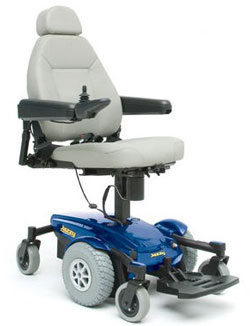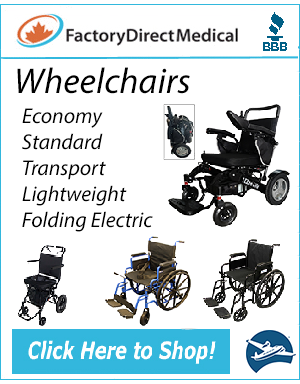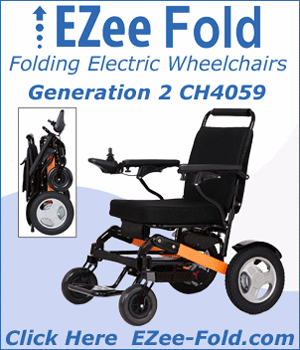
Pride Mobility - Jazzy Select 6
Power Elevating Seats
Mobility aside, one of the biggest challenges for wheelchair users is being able to reach upper cupboards, upper shelves, ATM's and many other items standing people don't give a thought to. Power wheelchairs with powered elevating seats aid wheelchair users in daily living tasks that they would normally find difficult, if not impossible.
Power elevating wheelchair seats are not very common options for wheelchair users and not every wheelchair manufacturer will offer them as options but many people find them a great help to making their lives more productive and independent. Power elevating seats are only available as optional equipment on power wheelchair bases.
Power wheelchairs with elevating seats are the best alternative available to the power stand-up wheelchairs. People who are not able to support their weight, or find standing painful, but still want to be able to reach items which are normally too high to reach while seated in a conventional wheelchair, will find wheelchairs with power elevating seats to be the answer.
These chairs are not portable and will not fold, most of the users of this category of wheelchair will likely be transported while sitting in the wheelchair and loaded into vehicles using a van lift or ramp.
How They Work
There are two different mechanisms for power elevating wheelchair seats that I'm familiar with and there might be others.
Single Post Elevating Seat
The single post elevating seat mechanism for wheelchairs is the most common. Within the post is a threaded rod that is turned by an electric motor and pushes the wheelchair seat up into the air. When the threaded rod rotates in the opposite direction, the seat will lower.
The elevating seat on these wheelchairs can be stopped at any point in their travel so the user can have infinite adjustability of their height.
Scissor Mechanism
The second type of elevating mechanism I've seen for power wheelchair elevating seats is the scissor mechanism. This system uses the same threaded rod mechanism used in the single post design but the rod now manipulates a scissor frame under the seat.
The big difference with the scissor type mechanism is the wheelchair seat frame is supported on all four corners rather than a single point in the center of the seat frame. This four point support may make the elevating seat be more stable for heavier users.
Power bases don't come standard with any type of seat frame but one will have to be ordered. People who do not need any seating products or seating supports can usually get away with a seat commonly referred to as a van seat. The van seat basically looks like a vehicle seat with armrests, padding and upholstery. The van seat may be available in a couple of sizes but there will be no option for customization or modification.
Safety
Because elevating the seat on a wheelchair will raise the center of gravity and make the wheelchair less stable, driving the wheelchair while elevated can create a dangerous situation.
Power wheelchair with elevating seats will either have an electrical cut off to prevent the chair from driving while the seat is elevated or an automatic electrical adjustment of the speed and acceleration of the chair.
The system where the chair slows down is the more common of the two systems because it is usually beneficial for the user to be able to move the chair without having to lower it.
Seat Frames
Elevating seat wheelchairs can be equipped with either an adjustable rehab type seat that can accommodate many types of off the shelf and custom seating options or a padded captain's chair type seat.
Frames and Weights
Power wheelchairs with power elevating seats are available for both rear wheel drive and mid wheel drive versions.
Mid wheel drive wheelchairs will be more manoeuvrable indoors and small spaces but harder to control at higher speeds. Rear wheel drive frames are more stable and controllable at higher speeds.
Turning Radius
The turning radius is the amount of free space required in each direction around the power wheelchair when turning a complete circle. The radius is one half of the diameter of the total circle. The smaller the turning radius, the more manoeuvrable the power wheelchair will be indoors. The turning radius for mid wheel drive power wheelchair will be between 20" and 3o" while the rear wheel drive versions will require 40" or more.
There are several factors which affect the turning radius on a power base. In addition to the frame length we have to take into account of how much the footrests extend beyond the front and rear of the power base frame. The seat position and size, plus the footrest type and angle all will have a bearing on turning radius.
Weight Capacity
Weight capacities for power base wheelchairs will be somewhere between 300 lbs. and 500 lbs. with heavy duty models accepting up to 1,000 lbs.
Wheels
The drive wheels are normally 12" to 14" in diameter and have a 2" to 4" width. The drive tires will usually be air filled but solid inserts are usually available.
The casters on the mid wheel drive power bases are at the back of the chair and are usually 8" in diameter. The front casters on a rear wheel drive power base will normally be either 8" or 9" and about 2" wide.



 Online Vendors
Online Vendors  US Online Vendors
US Online Vendors 

